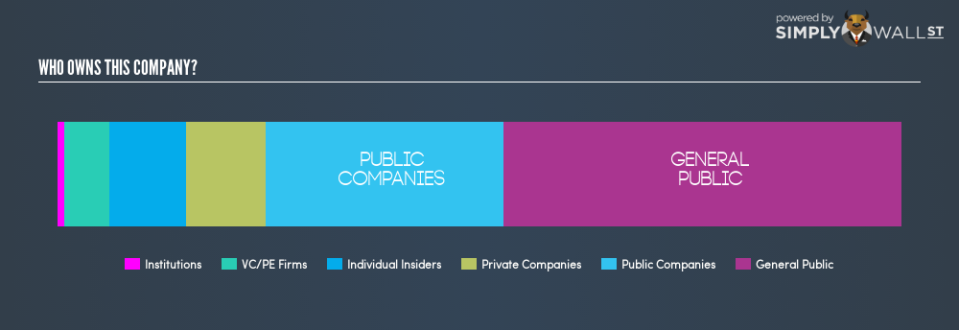Who Are The Major Shareholders Of Ausnutria Dairy Corporation Ltd (HKG:1717)?

In this analysis, my focus will be on developing a perspective on Ausnutria Dairy Corporation Ltd’s (HKG:1717) latest ownership structure, a less discussed, but important factor. A company’s ownership structure is often linked to its share performance in both the long- and short-term. Since the same amount of capital coming from an activist institution and a passive mutual fund has different implications on corporate governance, it is a useful exercise to deconstruct 1717’s shareholder registry.
See our latest analysis for Ausnutria Dairy
Institutional Ownership
Institutional investors transact in large blocks which can influence the momentum of stock prices, at least in the short-term, especially when there is a low level of public shares available on the market to trade. 1717 hardly has any institutional ownership, leaving investors little to think about sharp price volatility in the stock that could take place due to institutional trading.
Insider Ownership
I find insiders are an important group of stakeholders, who are directly involved in making key decisions related to the use of capital. In essence, insider ownership is more about the alignment of shareholders’ interests with the management. With 9.14% ownership, 1717 insiders is an important ownership type. An insider stake of this level indicates that executives are highly aligned with the shareholders as both stand to gain when the value of the company rises. I will also like to check what insiders have been doing recently with their holdings. insider buying may be a sign of upbeat future expectations, however, selling doesn’t necessarily mean the opposite as insiders may be motivated by their personal financial needs.
General Public Ownership
A substantial ownership of 47.06% in 1717 is held by the general public. With this size of ownership, retail investors can collectively play a role in major company policies that affect shareholders returns, including executive remuneration and the appointment of directors. They can also exercise the power to decline an acquisition or merger that may not improve profitability.
Private Equity Ownership
With a stake of 5.35%, private equity firms form another important class of owners in 1717. With a stake of 5.35%, they can influence 1717’s key policy decisions. This is a positive sign for potential investors as these firms play an important role in aligning company policy with shareholder returns.
Private Company Ownership
Another group of owners that a potential investor in 1717 should consider are private companies, with a stake of 9.32%. While they invest more often due to strategic interests, an investment can also be driven by capital gains through share price appreciation. This kind of ownership, if predominantly strategic, can give these companies a significant power to affect 1717’s business strategy. Thus, potential investors should look into these business relations and check how it can impact long-term shareholder returns.
Next Steps:
With a low level of institutional ownership, investors in 1717 need not worry about non-fundamental factors such as ownership structure causing large impact on stock prices. However, ownership structure should not be the only determining factor when you’re building an investment thesis for 1717. Rather, you should be examining fundamental factors such as the intrinsic valuation, which is a key driver of Ausnutria Dairy’s share price. I highly recommend you to complete your research by taking a look at the following:
Future Outlook: What are well-informed industry analysts predicting for 1717’s future growth? Take a look at our free research report of analyst consensus for 1717’s outlook.
Past Track Record: Has 1717 been consistently performing well irrespective of the ups and downs in the market? Go into more detail in the past performance analysis and take a look at the free visual representations of 1717’s historicals for more clarity.
Other High-Performing Stocks: Are there other stocks that provide better prospects with proven track records? Explore our free list of these great stocks here.
NB: Figures in this article are calculated using data from the last twelve months, which refer to the 12-month period ending on the last date of the month the financial statement is dated. This may not be consistent with full year annual report figures.
To help readers see past the short term volatility of the financial market, we aim to bring you a long-term focused research analysis purely driven by fundamental data. Note that our analysis does not factor in the latest price-sensitive company announcements.
The author is an independent contributor and at the time of publication had no position in the stocks mentioned. For errors that warrant correction please contact the editor at editorial-team@simplywallst.com.

 Yahoo Finance
Yahoo Finance 
